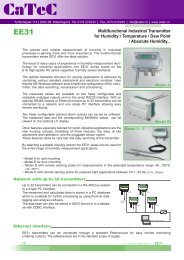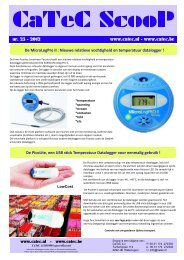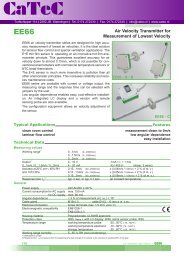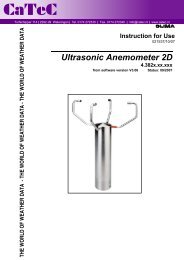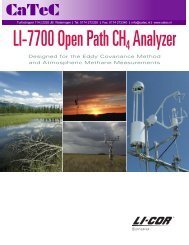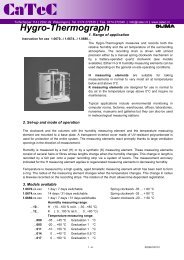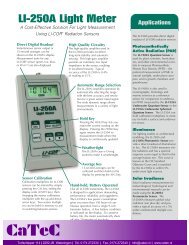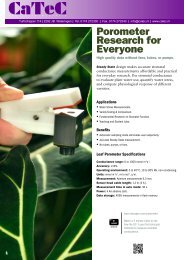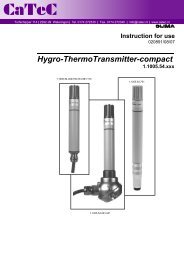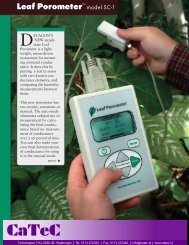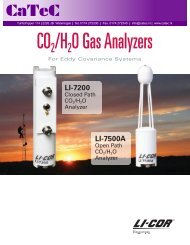li-190sa quantum sensor li-190sa quantum sensor
li-190sa quantum sensor li-190sa quantum sensor
li-190sa quantum sensor li-190sa quantum sensor
Create successful ePaper yourself
Turn your PDF publications into a flip-book with our unique Google optimized e-Paper software.
quantitative lamp measurements for photoresist processes, general<br />
lamp evaluation, qua<strong>li</strong>ty control, surface color measurements,<br />
photochemistry and photobiology.<br />
INNOVATIVE OPTICS<br />
The measurement optics of the LI-1800 has three major components<br />
— a filter wheel, holographic grating monochromator, and<br />
a si<strong>li</strong>con detector. The filter wheel contains seven order-sorting<br />
filters which e<strong>li</strong>minate second order harmonics and enhance<br />
stray <strong>li</strong>ght rejection by filtering out radiation that is not in the<br />
same spectral region as that being measured. The filter wheel<br />
also has a black target that serves as a dark reference for each<br />
scan.<br />
The dispersing element is a holographic grating monochromator<br />
which is available in two wavelength ranges; 300-850 nm with a<br />
4 nm bandwidth and 300-1100 nm with a 6 nm bandwidth.<br />
Optional monochromator s<strong>li</strong>ts are also available for changing the<br />
bandwidth and sensitivity to meet your app<strong>li</strong>cation.<br />
The monochromator is driven by a precision stepping motor<br />
under control of the internal microcomputer. Wavelength drive<br />
intervals are user selectable at 1, 2, 5 or 10 nm. The LI-1800’s<br />
high efficiency si<strong>li</strong>con detector and autoranging electronics<br />
allow scanning rates of over 30 nm per second.<br />
INTERNAL MICROCOMPUTER<br />
The heart of the LI-1800 system is the internal microcomputer<br />
which controls scanning and the collection, reduction and storage<br />
of data. Communication with the LI-1800 is accomp<strong>li</strong>shed<br />
using the 1800-01A Portable Terminal or any other RS-232<br />
terminal or computer. The LI-1800 is easy to use, yet powerful.<br />
A menu of simple commands covers all facets of operation from<br />
scanning to data output.<br />
SIMPLIFIED SCANNING<br />
Scanning is accomp<strong>li</strong>shed by one command; however, the<br />
LI-1800 lets you specify several parameters to get the scan you<br />
want, including wavelength <strong>li</strong>mits, wavelength drive interval,<br />
and the number of scans to average. Averaging scans provides<br />
accurate data under conditions of fluctuating radiation. Multiple<br />
scan averaging also improves sensitivity (signal to noise ratio) in<br />
low radiation conditions, since it reduces the noise level by a<br />
factor approaching the square root of the number of scans.<br />
After each scan the LI-1800 stores your data in its internal RAM<br />
memory. Standard memory in the LI-1800 is 256K bytes and is<br />
expandable to 512K bytes. The standard 256K memory typically<br />
holds 200 scans from 300-1100 nm (2 nm steps) or 530 scans<br />
from 400-700 nm.<br />
DATA REDUCTION<br />
The LI-1800’s built-in data reduction routines calculate irradiance,<br />
radiance, CIE chromaticity coordinates, illuminance,<br />
luminance, photon flux density, the ratio of spectral irradiance in<br />
two regions of a scan, and more. A data file can also be plotted<br />
on the 6000-03B Plotter/Printer using the LI-1800’s plotting<br />
routine.<br />
SPECIFICATIONS<br />
Holographic Grating Monochromator Options<br />
LI-1800/12 LI-1800/22<br />
Wavelength Range: 300-850 nm 300-1100 nm<br />
Standard Bandwidth<br />
(1/2 mm s<strong>li</strong>ts): 4 nm 6 nm<br />
Wavelength Accuracy: ± 1.5 nm ± 2 nm<br />
Wavelength<br />
Repeatabi<strong>li</strong>ty: ± 0.5 nm ± 0.5 nm<br />
Linear Dispersion: 8 nm/mm 12 nm/mm<br />
Grating:<br />
1200 grooves/mm 800 grooves/mm<br />
Automatic<br />
Filter Wheel: 6 filters 7 filters<br />
Noise Equivalent Irradiance<br />
(Standard cosine receptor, W cm -2 nm -1 )<br />
300-850 nm 300-1100 nm<br />
300 nm 6 × 10 -8 7 × 10 -8<br />
350 nm 4 × 10 -8 4 × 10 -8<br />
400 nm 2.5 × 10 -8 1.5 × 10 -8<br />
500-800 nm 8 × 10 -9 8 × 10 -9<br />
800-850 nm 2.5 × 10 -8 —<br />
800-1040 nm — 6 × 10 -9<br />
1100 nm — 1.5 × 10 -8<br />
Noise Equivalent Irradiance<br />
(1800-11 Remote Cosine Receptor, W cm -2 nm -1 )<br />
300-850 nm 300-1100 nm<br />
350 nm 2 × 10 -7 2 × 10 -7<br />
400 nm 1 × 10 -7 7 × 10 -8<br />
500-800 nm 3 × 10 -8 3.5 × 10 -8<br />
800-850 nm 1 × 10 -8 —<br />
800-1040 nm — 3 × 10 -8<br />
1100 nm — 6 × 10 -8<br />
NOTE: NEI is the noise of the instrument detector and amp<strong>li</strong>fier expressed in<br />
terms of the irradiance necessary to generate a detector output of an equivalent<br />
size. NEI values given are for standard 1/2 mm s<strong>li</strong>ts. Changing to 1 mm s<strong>li</strong>ts<br />
typically increases the sensitivity and reduces the NEI 3 to 4 times. The 1/4 mm<br />
s<strong>li</strong>ts decrease the sensitivity and increase the NEI 3 to 4 times.<br />
Maximum Irradiance Levels (W cm -2 nm -1 )<br />
300-400 nm 5 × 10 -3<br />
400-1000 nm > 1 × 10 -3<br />
Maximum irradiance levels are for 1/2 mm s<strong>li</strong>ts with standard<br />
teflon cosine receptor and filters.<br />
19



